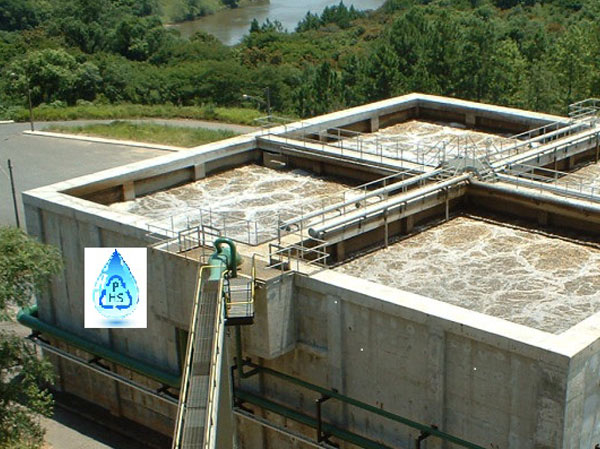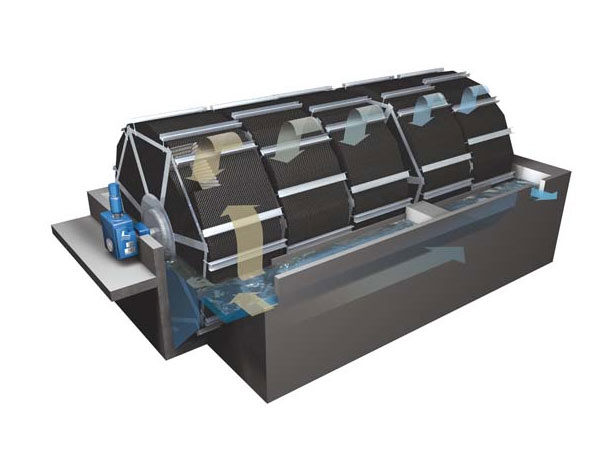
Our Solutions
Other Methods
Moving Media Bio Reactor (MMBR)
MBBR technology employs thousands of polyethylene biofilm carriers operating in mixed motion within an aerated waste water treatment basin. Each individual bio-carrier increases productivity through providing protected surface area to support the growth of heterotrophic and autotrophic bacteria within its cells. It is this high-density population of bacteria that achieves high-rate biodegradation within the system, while also offering process reliability and ease of operation.

Moving Bed Bioreactors (MBBR) biologically treat wastewater by circulating moving media in aerobic and anaerobic activated sludge environments. MBBR systems are an ideal treatment solution for high-strength wastewater or siting applications requiring a compact physical footprint. Upgrading existing treatment plants into MBBR systems can greatly enhance biological nitrogen removal (BNR) – expanding treatment capacity and improving effluent quality with no additional footprint expansion.
This technology provides cost-effective treatment with minimal maintenance since MBBR processes self-maintain an optimum level of productive bio film. Additionally, the bio film attached to the mobile bio-carriers within the system automatically responds to load fluctuations.
Rotating Biological Contactor (RBC):
Rotating biological contactor contain a number of rotating discs on a shaft submerged in a tank partially or completely filled with liquid. The primary treatment process removes the grit and other solids through a screening process followed by a period of settlement. The RBC process involves allowing the wastewater to come in contact with a biological medium in order to remove pollutants in the wastewater before discharge of the treated wastewater to the environment. A rotating biological contactor is a type of secondary treatment process. It consists of a series of closely spaced, parallel discs mounted on a rotating shaft which is supported just above the surface of the waste water. Microorganisms grow on the surface of the discs where biological degradation of the wastewater pollutants takes place.

The rotating packs of discs (known as the media) are contained in a tank or trough and rotate at between 2 and 5 revolutions per minute. The shaft is aligned with the flow of wastewater so that the discs rotate at right angles to the flow with several packs usually combined to make up a treatment train. About 40% of the disc area is immersed in the wastewater.
Biological growth is attached to the surface of the disc and forms a slime layer. The discs contact the wastewater with the atmospheric air for oxidation as it rotates. The rotation helps to slough off excess solids. The disc system can be staged in series to obtain nearly any detention time or degree of removal required.
The discs consist of polyethylene sheets ranging from 2 to 4 m in diameter and are up to 10 mm thick. Several modules may be arranged in parallel and/or in series to meet the flow and treatment requirements. The discs are submerged in waste water to about 40% of their diameter. Approximately 95% of the surface area is thus alternately submerged in waste water and then exposed to the atmosphere above the liquid.
Biofilms, which are biological growths that become attached to the discs, assimilate the organic materials in the wastewater. Aeration is provided by the rotating action, which exposes the media to the air after contacting them with the wastewater, facilitating the degradation of the pollutants being removed. The degree of wastewater treatment is related to the amount of media surface area and the quality and volume of the inflowing wastewater.
Membrane Bio-Reactor(MBR)
The MBR process is a suspended growth activated sludge system that utilizes micro porous membranes for solid/liquid separation. The membranes are immersed in wastewater. The MBR system draws wastewater through hollow fibers with microscopic pores small enough to filter out particulate matter and even individual bacteria.
The basic membrane bioreactor consists of two processing steps – a bioreactor, in which aerobic bacteria digest organic material in the presence of dissolved oxygen, and a membrane module, through which relatively pure water separates from the suspension of organic matter and bacteria. These two units may be set up to run in succession with a recycle of some of the separated sludge to the bioreactor.
Alternatively, the membranes are suspended in the slurry in the bioreactor, which is appropriately partitioned to achieve the correct air flows, with the surplus sludge withdrawn from the base of the bioreactor at a rate to give the required sludge retention time. This is then termed a submerged (or immersed) MBR.
The membrane bioreactor takes the place of the whole secondary stage of conventional activated sludge processing – and does it better, and in a much smaller space. The excess solids created by the oxidation process can then be easily removed for subsequent treatment. It is a continuous process, and one that is quite easily controlled.
The sludge settlement stage of the conventional secondary process is a fairly slow one, so the removal of the clear liquid from the slurry is a better option, and results in a cleaner liquid, because of the membrane filtration, at least to microfiltration standards, and more commonly to those of ultra-filtration.
A major advantage of the MBR system is that it can operate at a much higher solids concentration in the bioreactor than that of a conventional activated sludge plant. The MBR plant can work effectively at MLSS (mixed liquor suspended solids) concentrations typically in the range 8000 to 12,000 mg/l (or 0.8 to 1.2%), and has been demonstrated successfully at up to 3%, whereas conventional activated sludge plants work at about 2000 to 3000 mg/l, because of the limitations on settling.The longer sludge retention times in the MBR permit the destruction of molecules difficult to biodegrade, such as detergents. With proper system design nitrogen and phosphorus contents can also be significantly reduced.
Submerged Aerobic Fixed Film (SAFF)
SAFF or submerged aerobic fixed film reactors incorporates the advantages of fixed film technologies and combine with them the fine bubble diffused aeration techniques, to get a highly efficient biological treatment unit. It has as its main components, the BIOdekmedia and fine bubble diffused aeration grid. With the higher area surface of the BIOdek, higher organic loading rates are enabled, thus reducing the overall size required of the aeration tank. This leads to a considerable reduction in civil cost.
The system configurable enables better oxygen transfer efficiency with plug flow conditions.
Submerged fixed film growth in reactors sustains good microbial growth in adverse conditions and also handles shock loads very well. Sludge production is low; no sludge recirculations is required and mean cell residence time is enhanced. Requirement is basedonly on the organic load and mixing requirements are not called for, as this system is primarily an attached growth system.
This technology utilizes an aerobic fixed film process that is a combination submerged attached growth and activated sludge processes. This system is designed to be installed into a two compartment, where the first compartment provides majority of BOD removal, and the second compartment polishes the BOD. Rigid block-type media is submerged within the treatment module, providing surface area for microbial growth.
A bar screen was provided in the beginning to remove any floating material. Then an Oil & Grease Trap Chamber was provided to trap oil & grease. Since the sewage generation pattern was not regular, an equalization tanks was also installed that was designed for 3 hour duration of peak water flow. A SAFF Reactor was provided with special type media for attached growth of bacteria. For Sludge Handling, the sludge separated was designed to be collected in the thickener tank which reduces the quantity of sludge with a filter press provided for dewatering.

